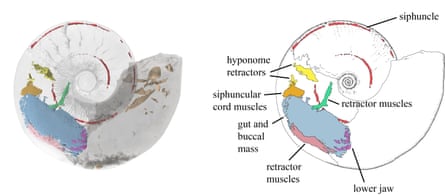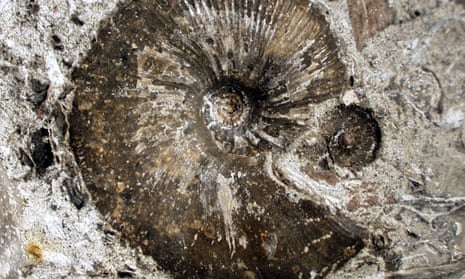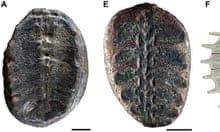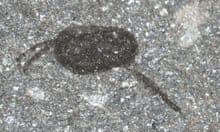Analysis of an extraordinary fossil discovered in a Gloucestershire gravel pit has given fresh insight into how an ancient sea creature swam through oceans and defended itself from predators millions of years ago.
Innovative imaging techniques have allowed scientists to build up a 3D picture of the inner workings of the ammonite, best known by the shell-shaped fossils found on beaches and sea cliffs.
The research has led them to conclude that the marine animal swam by jet propulsion using the hyponome – a muscular tube-like funnel through which water is expelled – as found in creatures such as squid and octopuses.
Researchers also pinpointed muscles that they believe allowed the ammonite to retract itself deep into its shell for protection. This would have been important since ammonites are believed to have lacked defensive features such as the ink sac found in modern squid and cuttlefish.
Ammonites thrived in oceans during the Mesozoic era but became extinct at the same time as non-avian dinosaurs about 66m years ago. Scientists have learned a lot about them through the fossilised remains of their shells, but little was known about the soft body within.

In 1998, Neville Hollingworth, an avid-fossil hunter, discovered an exceptionally well-preserved ammonite in an open gravel pit in Gloucestershire in 1998. It was unusual because it contained the fossilised remnants of soft tissue.
A research team led by scientists from Cardiff University has now used CT and neutron scanning to create a detailed 3D computer reconstruction of the creature’s muscles and organs.
Publishing their findings in Geology, the team say their work suggests ammonites may be evolutionarily closer to coleoids – the sub-group of animals containing squid, octopuses and cuttlefish – than previously thought. Up until now, scientists used the modern cephalopod nautilus as a body-plan for reconstructing ammonite biology.
The study’s lead author, Lesley Cherns of Cardiff University’s school of Earth and environmental sciences, said scientists had patiently waited for new techniques to emerge rather than carrying out more destructive research.

She said: “Preservation of soft parts is exceptionally rare in ammonites. Since the discovery of the fossil over 20 years ago, we have used numerous techniques to try to decipher the soft tissues, and have resisted the option of cutting it apart and hence destroying a unique specimen to see what is inside. We preferred to wait for the development of new, non-destructive technology – as now used in this study – to understand those internal features without harm to the fossil.”
Imran Rahman, a co-author and principal researcher at the Natural History Museum, added: “Ammonites are an iconic extinct group of marine animals renowned for their rich fossil record that stretches back hundreds of millions of years. Their hard shells made of calcium carbonate preserve well, however, important details of the living animal were largely still a mystery.
“In almost all cases, it’s only the hard shell – not the soft parts – preserved in fossil ammonites. On the rare occasions where soft parts have been found, they are mostly flattened.
“The preserved musculature described in our paper represents the strongest fossil evidence yet that ammonites swam using a muscular hyponome and could retract deep into the shell, which had previously been hypothesised on largely theoretical grounds.”
Hollingworth’s specimen is housed at the National Museum Cardiff.









